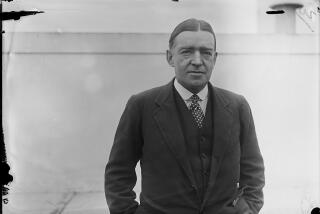Crew Tells of Historic Mission : Ship That Found Wreck of Titanic Returns Home
- Share via
WOODS HOLE, Mass. — Not surprisingly, they called it Operation Titanic.
Aboard the research vessel Knorr, French and American scientists pored over yellowing ships’ logs and detailed blueprints. The crew studied a special library of books and photographs. And for eight long days and nights, the 25 scientists and 24 crew members aboard the Knorr systematically searched the dark ocean floor, using still-experimental deep sea television and sonar equipment.
But pandemonium broke out shortly after 1 a.m. on Sept. 1 when the seven scientists in the Knorr’s computer-crammed command van finally found their goal: a sediment-covered boiler 13,000 feet down off Newfoundland’s Grand Banks. They had found the Titanic.
Big Welcome
Returning home Monday afternoon, the freshly scrubbed, red-and-white Knorr steamed into the kind of welcome that might have greeted the Titanic had the famed luxury liner completed its maiden transatlantic voyage 63 years ago. Ship horns blared, a cannon roared, hundreds cheered from piers and rooftops, festive balloons spiraled high, champagne corks popped, banners fluttered and dozens of reporters clamored.
Most of the crew sported blue-and-yellow Operation Titanic patches, showing the ship that rammed an iceberg on a calm moonless night on April 14, 1912, and sank 2 1/2 hours later, taking more than 1,500 lives. Only about 700 survived.
Robert D. Ballard, chief scientist and guiding force behind Operation Titanic, said the ship now rests upright in “gently sloping alpine-like country,” the bow facing north, the bow anchors and cranes still snugly in place 2 1/2 miles below the surface.
‘Quiet and Peaceful’
“There is no light at that depth, nor is there ever likely to be,” said Ballard, 43, his voice cracking as he spoke. “It’s a quiet and peaceful place. It’s a fitting place for this greatest of sea tragedies to rest. Forever may it remain that way. God bless these new-found souls.”
Adm. Bradford Mooney, chief of the U.S. Office of Naval Research, said Monday after greeting the Knorr that the Navy would consider backing another expedition to the Titanic. The Navy owns the Knorr and has a $2.8-million, five-year contract with the Woods Hole Oceanographic Institution to develop and test the unmanned submersible called the Argo that was used to find the Titanic.
French scientists from the French Institute for Research and Exploration of the Sea began the search in July in a collaborative effort with the Institution. For 23 days, with Ballard on board, the French ship Le Suroit used deep-sea high-resolution sonar, but found nothing.
Knorr Joins Search
On Aug. 23 the Knorr joined the search. On board was the Navy’s Argo, a 10-foot-long white metal sled armed with three ultrasensitive television cameras, powerful strobe lights and side scanning sonar. Around the clock for eight days and nights, the Knorr towed the Argo over an endlessly muddy bottom and house-sized boulders.
On the night of Sept. 1, the Argo began transmitting pictures of debris--coal, mostly. Then a huge piece of equipment came into view on the 20 flickering screens in the blue command van on the Knorr’s stern.
Dr. Jean Marie Michelle, the chief French scientist aboard, quickly identified it from the Titanic’s original photos. It was one of the ship’s 29 boilers.
“Everybody went nuts,” agreed research assistant Steve Gregg. “But it was sobering too. We realized what we were looking at.”
After pulling up the Argo and calming down, the entire ship’s crew gathered at the fantail at about 2:40 a.m. for a moment of silence. A copy of the flag that flew on the Titanic was run up a stern flagpole.
“It was much later, one or two days, before we found the hulk,” said Stewart Harris, a project engineer aboard the Knorr. Then, for five days, the Argo slowly photographed the wreck, alternating with another unmanned deep-sea sled called the Angus, which took high resolution, 35-millimeter photographs. More than 12,000 photos were taken in all.
“What you’ve seen so far is not even the tip of the iceberg,” Harris said of the photos.
More to Read
Sign up for Essential California
The most important California stories and recommendations in your inbox every morning.
You may occasionally receive promotional content from the Los Angeles Times.














